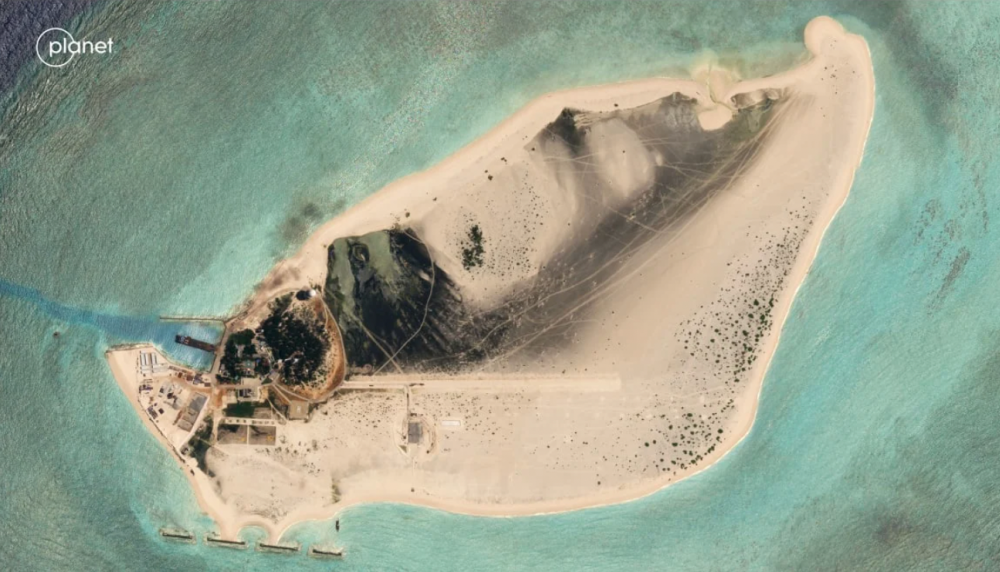A small island in the South Pacific is claimed by China, although also claimed by Taiwan and Vietnam. Triton Island is an archipelago, the westernmost island of the Paracel Islands near Vietnam. China has been occupying the island since the 1970s regardless of the dispute over its ownership.
It is known that Beijing has been slowly building up reefs into islands in the South China Sea for years, adding military outposts and assets over time, including missiles, radar systems, and airstrips. In many cases where islands didn’t exist in the sea, China has taken it upon itself to create new islands entirely, drawing condemnation from the United States, which has sanctioned the Chinese entities that helped Beijing build artificial islands and militarize them, Yahoo News reports.
The buildup on the islands could help China with key logistics that could help it project force in the region, which is particularly concerning given Beijing’s increasingly aggressive and coercive behavior in the region in recent months, according to Kitsch Liao, assistant director of the Atlantic Council’s Global China Hub.
Woody Island, China’s major military base in the Paracel Islands, already boasts a population of around 1,000 people, an airstrip, hangars for combat aircraft, and HQ-9 surface-to-air missile batteries. Now it is evident that China has begun building what appears to be an airstrip on a disputed island in the South China Sea, according to satellite images taken this month and shared with The Daily Beast.
One satellite image, taken by Planet Labs PBC on August 10 and analyzed by The Daily Beast, shows new construction on Triton Island. Compared with a Planet Labs PBC satellite image of the same island in March, Beijing has been busy building up the island, which measures about 1 mile by several thousand feet across, according to maps.
And, the construction of the airstrip on Triton Island began in the last few weeks, according to The Drive, which first reported on the development. The airstrip is likely more than 600 meters or about 2,000 feet long, which could accommodate turboprop aircraft and drones, according to an analysis from the Associated Press.
Yahoo News noted:
The airstrip is the latest indication that Beijing is continuing to militarize islands as part of a broader strategy to expand China’s presence in the South China Sea. Just last year, China had fully militarized three islands in the South China Sea, in a move that the Pentagon assessed was aimed at destabilizing the region and allowing China to extend its offensive capabilities beyond its own shores, by flying fighters, bombers, and more.
The use of the islands by China is speculated to focus on Vietnam, and it is thought that the nature of the islands themselves point to recon and beginning phases of a conflict.
“The main target of Triton Island is Vietnam, not Taiwan,” Kitsch Liao, assistant director of the Atlantic Council’s Global China Hub told The Daily Beast. “This is [the] Chinese grand strategy in the SCS. From the preliminary assessment, the build-up on Triton Island may be a secondary base in the Paracel Islands [which could] function as [an] auxiliary base for the main base on the Woody Island.”
“The Great Walls of SCS have been built on sand, which are vulnerable during the war because they are not defensible,” Si-fu Ou, of Taiwan’s Institute for National Defense and Security Research said. “In peacetime, however, the man-made islands are quite useful to conduct a variety of the missions, for instance, presence, ISR (intelligence, surveillance, and reconnaissance), situation awareness, and gray zone-tactics.”
The Triton Island buildup could also be an attempt at making a potential move to seize Taiwan more complicated for China’s enemies to successfully counteract, Brad Martin, a retired U.S. Navy officer and a senior policy researcher at RAND, told The Daily Beast.
“It’s just a way of multiplying places to put things. And in addition, the more places they have to put things, if a war should occur, the more places they can go, the more places the United States and its partners, and allies have to target. And that creates a resource drain for the force. It will be trying to defend Taiwan,” said Martin, who previously served as an operations analyst at the Pentagon’s Office of the Chief of Naval Operations. “The more lily pads there are, the more places there are to play Whac-A-Mole, the harder it is for the opposing force to deal with it.”
China has previously claimed that its island buildup is only defensive in purpose. But its buildup on islands overlaps with territorial interests from Brunei, Malaysia, Taiwan, Vietnam, and the Philippines as well as trade routes. China’s Coast Guard has also had a series of run-ins with the Philippines this year in the Spratly Islands, Yahoo reports.
China’s denial of the obvious initiative has caused the U.S. to send near the disputed islands. U.S. guided-missile destroyer to conduct “freedom of navigation operations” (FONOPs) near the Paracel Islands and Spratly Islands on at least two occasions this year, as it has in previous years, to prove the point.

